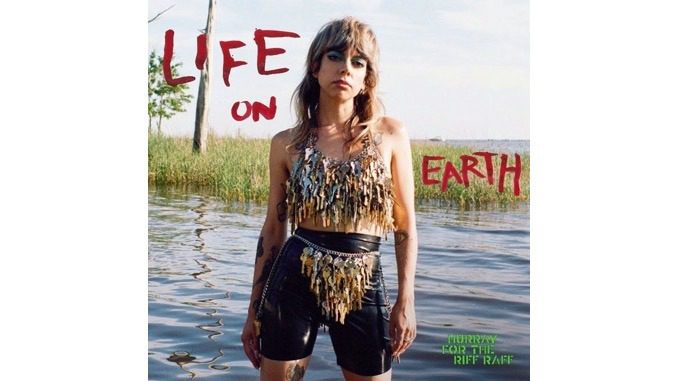Reinvention happens. Artists evolve over time, all the time: Against Me!, for instance, or Taylor Swift, or Joni Mitchell. Life on Earth, the seventh album by New Orleans-via-New York folk-blues-punk project Hurray for the Riff Raff, qualifies as reinvention on the same level, with a caveat: singer/songwriter and frontperson Alynda Segarra has taken such leaps over the last decade and a half as a human being, as well as a musician, that their efforts on Life on Earth express reinvention less than they do rebirth. It’s rare for a record so deep in a band’s discography to function as a fresh start after establishing a style, not to mention a personality, over so many years.
Segarra pulls off that trick in part because Hurray for the Riff Raff’s last album, The Navigator, did heavy lifting setting the stage for change. On The Navigator, Segarra wrestled with their Puerto Rican heritage in transition after seamless transition from track to track, stringing together a tight, cohesive story about their background and the weight it lays on their shoulders; through each song, they considered Puerto Rico and their Puerto Rican-ness, and the responsibility they have to both as a child of the country and as a musician. That’s a big damn burden for one person to carry, but Segarra carried it with their own strength and their band’s combined strength, too-Casey McAllister, Dan Cutler, Sam Doores and Yosi Perlstein. Now, they carry that burden through to Life on Earth.
Seventh acts aren’t often this urgent or original. We’ll never know because we don’t live in an alternate timeline where Life on Earth is Hurray for the Riff Raff’s debut, but if you hear it without knowing the author, you might guess it’s the product of a new act instead of veteran talent. Obviously, you’d be wrong, but therein lies the album’s raw power as an act of awakening: With Segarra’s newfound sense of self and a new outlook on life and the world comes a new sound, and a new mission, both related to the old but attuned to the moment. Music is slightly better positioned to pick its time than, say, film and TV; had COVID never happened, Segarra might have made a different record than Life on Earth. But COVID is still happening, and so Life on Earth reads as a reaction to its effects on American life.
If The Navigator saw Segarra reconcile their Puerto Rican ancestry, then Life on Earth feels like their attempt to reconcile their Earthling status. Currently, living on this planet sucks. At any given moment, one part of the world could be on fire while another is underwater. Think of Life on Earth as a guide for staying alive and going to ground even when it seems like there’s no ground to go to: From the very first song, “Wolves,” Segarra appears to be giving their listeners tools for evading danger and death. Segarra knows what they’re talking about-they left home at 17 and have lived all over the U.S.-and through their knowledge they tap into common disasters, from wildfires and tornadoes to hurricanes and blizzards, that have left Americans displaced or dead. “It’s not safe at home anymore,” Segarra sings over slow drum and bass beats and buzzing synth on the chorus. They don’t point to where “safe” actually is (“some distant shore,” goes one verse), but the warning suffices.
There’s an electronic slickness to “Wolves” that sounds unfamiliar to Hurray for the Riff Raff’s aesthetic, but “unfamiliar” works. It’s otherworldly. Besides, “familiar” remains a fixture on the record in tracks like “Rhododendron,” a piece of fast-paced folk-punk that stitches the environmental motif with thoughts on man’s brutality toward man. Segarra rattles off plant names like a botanist-foxglove, nightshade, jasmin, chamico, morning glory-and contrasts them with protest imagery (“police barricade”) alongside barbarism (“Addicted to the / High of violence”). Being human means appreciating the harmony in nature while fighting against our most savage natural instincts. “Rhododendron”’s genre suits what Segarra’s communicating in their lyrics.
Life on Earth visits these concepts, back and forth, over all of its 11 tracks, but Segarra captures all of them under one umbrella in the album’s namesake centerpiece, where they play a gorgeous, somber piano tune in a place of warmth and gloom, reflecting on the state of Earth and all its inhabitants. “Life on Earth” feels like a cousin to The Navigator’s spotlight song, “Pa’lante,” a plea to remember where one comes from and a call to action all at once; the difference is that “Life on Earth” touches on beauty (“Monarchs in flight / The dawn’s early light”) and horror (“The girl in a cage with / The moon in her eye”) with melancholy that, depending on your mood, may read either as hopeful or nihilistic.
David Fincher’s Seven is the last place anyone’s mind will go when experiencing Life on Earth, but Morgan Freeman’s last line of dialogue in that film unexpectedly relates to Segarra’s work nonetheless. “‘The world is a fine place and worth fighting for,’” he sighs, quoting Ernest Hemingway. “I agree with the second part.” Segarra likely agrees with both parts, but they’re so tuned into surviving ugliness that everything that makes the world such a fine place feels like auxiliary detail. What matters are the travails we endure to appreciate goodness. Life on Earth is a journey through the former toward the latter, and a dazzling shift from Hurray for the Riff Raff’s roots to their present.
Bostonian culture journalist Andy Crump covers the movies, beer, music, and being a dad for way too many outlets, perhaps even yours. He has contributed to Paste since 2013. You can follow him on Twitter and find his collected work at his personal blog. He’s composed of roughly 65% craft beer.




